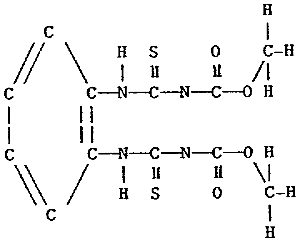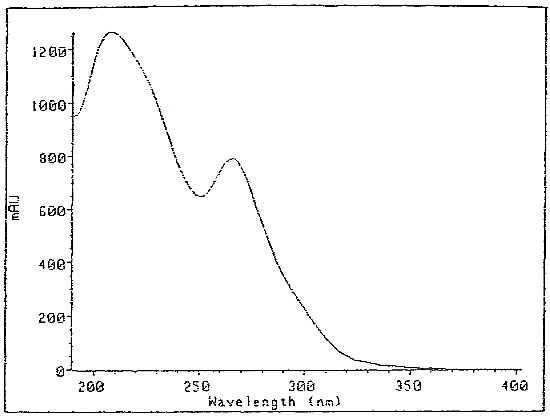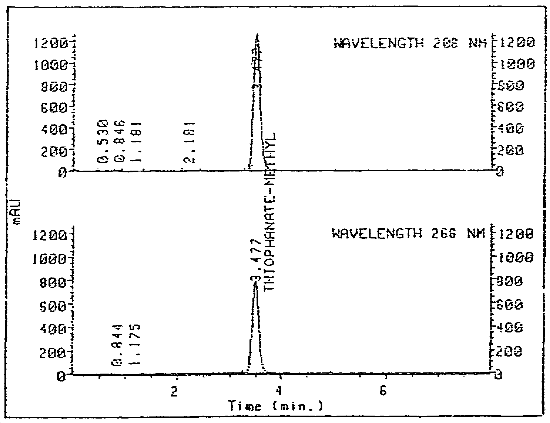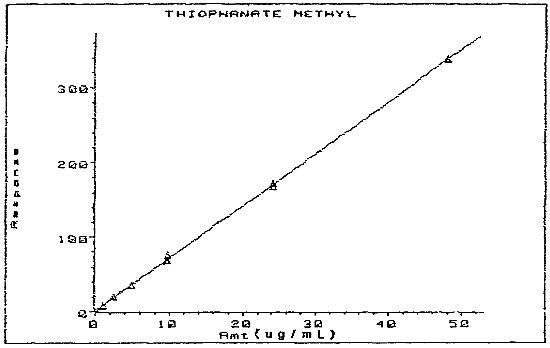Thiophanate-methyl
| Method number: | PV2058 |
| Matrix: | Air |
| Target Concentration: | 0.4 mg/m3 (arbitrary) There is no OSHA
permissible exposure level (PEL) or ACGIH threshold limit value
(TLV) for |
| Procedure: | Samples are collected by drawing known volumes of air through glass fiber filters. Samples are extracted with acetonitrile and analyzed by high performance liquid chromatography (HPLC) using an ultraviolet (UV) detector. |
| Recommended air volume and sampling rate: | 240 L at 1.0 L/min |
| Detection limit of the overall procedure (based on the recommended air volume and the analytical detection limit): | 10 µg/m3 |
| Status of method: | Stopgap method. This method has been only partially evaluated and is presented for information and trial use. |
| Date: January 1989 (final) | Chemist: Duane Lee |
Carcinogen And Pesticide Branch
OSHA Analytical
Laboratory
Salt Lake City, Utah
1. General Discussion
- 1.1. Background
- 1.1.1. History of procedure The OSHA Analytical Laboratory
received a set of air samples requesting the analysis of
1.1.2. Toxic effects (This section is for information only and should not be taken as the basis of OSHA policy.)
The acute oral LD50 in rats has been reported to be 7500 mg/kg and 6640 mg/kg. (Ref. 5.1. and 5.2.)
1.1.3. Potential workplace exposure
Thiophanate-methyl has a broad spectrum of plant disease control in vegetables, fruit, turf, soybeans, peanuts, almonds, celery (Ref 5.2.). No estimate of worker exposure to thiophanate-methyl could be found.
1.1.4. Physical properties (Ref. 5.1. to 5.3.)
| Molecular weight: | 342.42 |
| Molecular formula: | C12H14N 4O4S2 |
| CAS #: | 23564-05-8 |
| IMIS number: | D347 |
| Melting point: | 168°C with decomposition |
| Solubility: | soluble in acetone, methanol, chloroform, acetonitrile; slightly soluble in other organics; insoluble in water |
| Chemical name: | Dimethyl ((1,2-phenylene)
|
| Synonyms: | Cercobin-M, Mildothane, Topsin H, Labilite |
| Description: | colorless crystalline solid |
| UV scan: | Figure 1. |
| Structure: |  |
1.2. Limit defining parameters
The detection limit of the analytical procedure is 0.5 ng per injection. This is the amount of analyte which will give a peak whose height is approximately five times the baseline noise.
2. Sampling procedure
- 2.1. Apparatus
- 2.1.1. A personal sampling pump that can be calibrated to within
± 5% of the recommended flow rate with the sampling device in line.
2.1.2. Glass fiber filters,
2.1.3. Cassette filter holder for
2.2. Reagents
No sampling reagents are required.
2.3. Sampling technique
- 2.3.1. Immediately before sampling, remove the plastic plugs
from the cassette.
2.3.2. Attach the cassette to the sampling pump with flexible tubing.
2.3.3. Attach the cassette vertically in the employee's breathing zone in such a manner that it does not impede work performance.
2.3.4. After sampling for the appropriate time, remove the cassette and seal with plastic plugs.
2.3.5. Wrap each cassette
2.3.6. Record the air volume for each sample, and list any possible interferences.
2.3.7. Submit at least one blank for each set of samples. Handle the blank in the same manner as the samples, except no air is drawn through it.
2.3.8. Submit bulk samples for analysis in a separate container.
2.4. Extraction efficiency
Twenty-four glass fiber filters were each liquid spiked with 40 µL of a 2.442 mg/mL thiophanate-methyl standard. After drying, six of the glass fiber filters were each extracted with 5 mL of acetonitrile, shaken for 30 min and then analyzed as in section 3. The results are listed in the following table.
Table 2.4.
Extraction Efficiency
| Amount | Amount | % | |
| Sample # | Spiked, µg | Found, µg | Recovered |
| Ex1 | 97.68 | 92.46 | 94.7 |
| Ex2 | 97.68 | 91.93 | 94.1 |
| Ex3 | 97.68 | 93.36 | 95.6 |
| Ex4 | 97.68 | 87.78 | 89.9 |
| Ex5 | 97.68 | 85.45 | 87.5 |
| Ex6 | 97.68 | 96.95 | 99.3 |
| Average = | 93.5 |
2.5. Retention efficiency
The remaining 18 glass fiber filters from above had 240 L of humid air (~80% relative humidity) drawn though them. Six of the filters were then each extracted with 5 mL of acetonitrile, shaken for 30 min and then analyzed as in section 3. The results are listed in Table 2.5. The rest of the filters were kept, 6 in a drawer at ambient temperature and 6 in a freezer, for storage studies.
Table 2.5.
Retention Efficiency
| Amount | Amount | % | |
| Sample # | Spiked, µg | Found, µg | Recovered |
| R1 | 97.68 | 95.01 | 97.3 |
| R2 | 97.68 | 95.93 | 98.2 |
| R3 | 97.68 | 99.89 | 102.3 |
| R4 | 97.68 | 94.67 | 96.9 |
| R5 | 97.68 | 99.18 | 101.5 |
| R6 | 97.68 | 103.4 | 105.9 |
| Average = | 100.4 |
2.6. Sample storage
After 5 days of storage; 6 samples, 3 from ambient storage and 3 from freezer storage, were each extracted with 5 mL of acetonitrile, shaken for 30 min and then analyzed as in section 3. The remaining samples were extracted and analyzed after 8 days of storage. The results are given in the following Tables.
Table 2.6.1.
Ambient Storage
| Days | Amount | Amount | % |
| Stored | Spiked, µg | Found, µg | Recovered |
| 5 | 97.68 | 97.63 | 99.9 |
| 5 | 97.68 | 96.05 | 98.3 |
| 5 | 97.68 | 104.51 | 107. |
| 8 | 97.68 | 98.16 | 100.5 |
| 8 | 97.68 | 96.32 | 98.6 |
| 8 | 97.68 | 89.55 | 91.7 |
| Average of 5 days = | 101.7 | ||
| Average of 8 days = | 96.9 |
Table 2.6.2
Freezer Storage
| Days | Amount | Amount | % |
| Stored | Spiked, µg | Found, µg | Recovered |
| 5 | 97.68 | 96.25 | 98.5 |
| 5 | 97.68 | 96.97 | 99.3 |
| 5 | 97.68 | 102.3 | 104.7 |
| 8 | 97.68 | 97.14 | 99.4 |
| 8 | 97.68 | 98.24 | 100.6 |
| 8 | 97.68 | 97.52 | 99.8 |
| Average of 5 days = | 100.8 | ||
| Average of 8 days = | 99.9 |
2.7. Recommended air volume and sampling rate
- 2.7.1. The recommended air volume is 240 L.
2.7.2. The recommended flow rate is 1.0 L/min.
2.8. Interferences (sampling)
It is not known if any compounds will interfere with the collection
of
2.9. Safety precautions (sampling)
- 2.9.1. Attach the sampling equipment in such a manner that it
will not interfere with work performance or employee safety.
2.9.2. Follow all safety practices that apply to the work area being sampled.
3. Analytical procedure
- 3.1. Apparatus
- 3.1.1. A balance capable of weighing to the nearest tenth of a
milligram. A Mettler HL52 balance was used in this evaluation.
3.1.2. A mechanical shaker.
3.1.3. An HPLC with a UV detector. A Hewlett Packard 1090 liquid chromatograph with a diode array detector was used in this evaluation.
3.1.4. An HPLC column capable of separating
3.1.5. An electronic integrator, or some other suitable means for
measuring detector response. The
3.1.6. Volumetric flasks and pipets various sizes.
3.1.7. Scintillation vials,
3.1.8. Vials,
3.2. Reagents
- 3.2.1. Acetonitrile, HPLC grade.
3.2.2. Water, HPLC grade.
3.2.3.
3.3. Standard preparation
Prepare
3.4. Sample preparation
- 3.4.1. Transfer the glass fiber filter to a scintillation vial.
3.4.2. Add 5.0 mL of acetonitrile to each vial and seal with a
3.4.3. Shake the vials for 30 minutes on a mechanical shaker.
3.4.4. Transfer the sample to a
3.5. Analysis
- 3.5.1. Instrument conditions
| Column: | 5 µm Hypersil ODS, 100 mm x 2.1 mm |
| Oven temperature: | 40°C |
| Mobile phase: | 30% acetonitrile |
| 70% water | |
| Flow: | 0.3 mL/min |
| Wavelengths: | 266 nm and 208 nm |
| Injection volume: | 1.0 µL |
| Retention time: | 3.46 min |
3.5.2. Chromatogram (Figure 2.)
3.6. Interferences (analytical)
- 3.6.1. Any collected compound having a similar retention time to
that of
3.6.2. HPLC conditions may be varied to circumvent interferences.
3.6.3. Retention time alone on a single column is not proof of chemical identity. Analysis by an alternate HPLC column, comparison of wavelength responses or confirmation by mass spectrometry are additional means of identification.
3.7. Calculations
- 3.7.1. Construct a calibration curve (Figure 3.) by plotting
detector response versus concentration (µg/mL) of
3.7.2. Determine the µg/mL of
3.7.3. Blank correct the sample by subtracting the µg/mL found in the blank from the µg/mL found in the sample.
3.7.4. Determine the air concentration by using the following formula.
| mg/m3 = | (µg/mL in sample) × (extraction
volume, mL)
(air volume, L) × (extraction efficiency, decimal) |
3.8. Safety precautions (analytical)
- 3.8.1. Avoid skin contact and air exposure to
3.8.2. Avoid skin contact with all solvents.
3.8.3. Wear safety glasses at all times.
4. Recommendation for further study
This method should be fully validated.

Figure 1.
UV Scan of 
Figure 2.
Chromatogram of

Figure 3.
Calibration Curve
5. References
- 5.1. Registry of Toxic Effects of Chemical Substances
5.2. Farm Chemicals Handbook; Berg, Gordon L. Ed.; Meister: Willoughby, Ohio, 1986; p C231.
5.3. Merck Index, 10th ed.; Windholz, Martha Ed.; Merck:
Rathway, N.J., 1983; pp